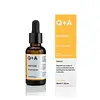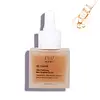What's inside
What's inside
 Key Ingredients
Key Ingredients

 Benefits
Benefits

 Concerns
Concerns

 Ingredients Side-by-side
Ingredients Side-by-side

Water
Skin ConditioningPropylene Glycol
HumectantBetaine
HumectantPentylene Glycol
Skin ConditioningXanthan Gum
EmulsifyingAloe Barbadensis Leaf Juice Powder
Skin ConditioningSodium Phytate
Glycerin
HumectantLonicera Caprifolium Flower Extract
PerfumingBiosaccharide Gum-1
HumectantLonicera Japonica Flower Extract
Skin ConditioningSodium Levulinate
Skin ConditioningTripeptide-29
Skin ConditioningSodium Hyaluronate
HumectantSodium Ascorbyl Phosphate
AntioxidantMagnesium PCA
HumectantLactic Acid
BufferingGlyceryl Caprylate
EmollientCocoyl Proline
Skin ConditioningSodium Anisate
AntimicrobialLeuconostoc/Radish Root Ferment Filtrate
AntimicrobialCitric Acid
BufferingWater, Propylene Glycol, Betaine, Pentylene Glycol, Xanthan Gum, Aloe Barbadensis Leaf Juice Powder, Sodium Phytate, Glycerin, Lonicera Caprifolium Flower Extract, Biosaccharide Gum-1, Lonicera Japonica Flower Extract, Sodium Levulinate, Tripeptide-29, Sodium Hyaluronate, Sodium Ascorbyl Phosphate, Magnesium PCA, Lactic Acid, Glyceryl Caprylate, Cocoyl Proline, Sodium Anisate, Leuconostoc/Radish Root Ferment Filtrate, Citric Acid
Water
Skin ConditioningPropanediol
SolventPropolis Extract
Skin ConditioningGlycerin
HumectantSodium Lactate
BufferingXylitylglucoside
HumectantSodium Cocoyl Amino Acids
CleansingSodium Hyaluronate
HumectantAnhydroxylitol
HumectantHoney Extract
HumectantBeta-Glucan
Skin ConditioningLonicera Japonica Flower Extract
Skin ConditioningCamellia Sinensis Leaf Extract
AntimicrobialCeratonia Siliqua Gum
EmollientXanthan Gum
EmulsifyingSarcosine
Skin ConditioningLactic Acid
BufferingXylitol
HumectantLonicera Caprifolium Flower Extract
PerfumingPropylene Glycol
Humectant1,2-Hexanediol
Skin ConditioningCaprylyl Glycol
EmollientSodium Phytate
Boswellia Serrata Extract
Skin ConditioningAloe Barbadensis Leaf Juice Powder
Skin ConditioningElettaria Cardamomum Seed Extract
PerfumingPistacia Lentiscus Gum
MaskingMagnesium Aspartate
Skin ConditioningPotassium Aspartate
Skin ConditioningWater, Propanediol, Propolis Extract, Glycerin, Sodium Lactate, Xylitylglucoside, Sodium Cocoyl Amino Acids, Sodium Hyaluronate, Anhydroxylitol, Honey Extract, Beta-Glucan, Lonicera Japonica Flower Extract, Camellia Sinensis Leaf Extract, Ceratonia Siliqua Gum, Xanthan Gum, Sarcosine, Lactic Acid, Xylitol, Lonicera Caprifolium Flower Extract, Propylene Glycol, 1,2-Hexanediol, Caprylyl Glycol, Sodium Phytate, Boswellia Serrata Extract, Aloe Barbadensis Leaf Juice Powder, Elettaria Cardamomum Seed Extract, Pistacia Lentiscus Gum, Magnesium Aspartate, Potassium Aspartate
Ingredients Explained
These ingredients are found in both products.
Ingredients higher up in an ingredient list are typically present in a larger amount.
Aloe Barbadensis Leaf Juice Powder comes from the aloe plant.
You may know Aloe to be a good sunburn reliever and inflammation reducer. This is because it contains many components that are known to help reduce irritation and itchiness.
Aloe leaves are also great moisturizers. They are naturally rich in polysaccharides, a carbohydrate made of sugars. Polysaccharides are able to mimic the carbs found in the top layer of your skin. This can help keep your skin hydrated.
Aloe contains the antioxidants Vitamins A, C, and E. These vitamins neutralize free radicals. Free-radicals are molecules that may damage your skin cells, such as pollution.
Aloe does not protect against UV rays, despite it soothing sunburns.
Learn more about Aloe Barbadensis Leaf Juice PowderGlycerin is already naturally found in your skin. It helps moisturize and protect your skin.
A study from 2016 found glycerin to be more effective as a humectant than AHAs and hyaluronic acid.
As a humectant, it helps the skin stay hydrated by pulling moisture to your skin. The low molecular weight of glycerin allows it to pull moisture into the deeper layers of your skin.
Hydrated skin improves your skin barrier; Your skin barrier helps protect against irritants and bacteria.
Glycerin has also been found to have antimicrobial and antiviral properties. Due to these properties, glycerin is often used in wound and burn treatments.
In cosmetics, glycerin is usually derived from plants such as soybean or palm. However, it can also be sourced from animals, such as tallow or animal fat.
This ingredient is organic, colorless, odorless, and non-toxic.
Glycerin is the name for this ingredient in American English. British English uses Glycerol/Glycerine.
Learn more about GlycerinLactic Acid is another well-loved alpha hydroxy acid (AHA). It is gentler than glycolic acid but still highly effective.
Its main role is to exfoliate the surface of the skin by loosening the “glue” that holds dead skin cells together. Shedding those old cells leads to smoother, softer, and more even-toned skin.
Because lactic acid molecules are larger than glycolic acid, they don’t penetrate as deeply. This means they’re less likely to sting or irritate, making it a great choice for beginners or those with sensitive skin.
Like glycolic acid, it can:
Lactic acid also acts as a humectant (like hyaluronic acid). It can draw water into the skin to improve hydration and also plays a role in the skin's natural moisturizing factor (NMF) in the form of sodium lactate.
Studies show it can boost ceramide production to strengthen the skin barrier and even help balance the skin’s microbiome.
To get results, choose products with a pH between 3-4.
Lower strengths (5-12%) focus on surface exfoliation; higher strengths (12% and up) can reach deeper in the dermis (deeper, supportive layer) to improve skin texture and firmness over time.
Though it was originally derived from milk, most modern lactic acid used in skincare is vegan. It is made through non-dairy fermentation to create a bio-identical and stable form suitable for all formulations.
When lactic acid shows up near the end of an ingredient list, it usually means the brand added just a tiny amount to adjust the product’s pH.
Legend has it that Cleopatra used to bathe in sour milk to help reduce wrinkles.
Lactic acid is truly a gentle multitasker: it exfoliates, hydrates, strengthens, and brightens. It's a great ingredient for giving your skin a smooth, glowing, and healthy look without the harshness of stronger acids.
Read more about some other popular AHA's here:
Learn more about Lactic AcidThis Honeysuckle flower extract comes from the Italian honeysuckle. It is an antioxidant, antimicrobial, and fragrance.
Both this and the Japanese Honeysuckle are rich in a natural paraben that give it antimicrobial property. They are effective in inhibiting bacteria, yeast, and mold.
Honeysuckle contains flavonoids and saponins. Both of these components are natural antioxidants that can help soothe the skin.
As most flowers do, honeysuckle has a natural fragrance.
Learn more about Lonicera Caprifolium Flower ExtractLonicera Japonica Flower Extract comes from the honeysuckle flower.
Honeysuckles have skin protecting, anti-viral, and anti-inflammatory properties. It contains many antioxidants, such as luteolin, caffeic acid, loniflavone, and chlorogenic acids.
This honeysuckle is native to East Asia and used in traditional Chinese medicine to treat fever and inflammation.
Learn more about Lonicera Japonica Flower ExtractPropylene Glycol is an odorless, colorless liquid. As a humectant, it helps skin retain moisture. It also aids in delivering active ingredients.
Another role of this ingredient is preventing a product from melting or freezing. Propylene glycol also adds antimicrobrial properties to a product, elongating product lifespan.
This ingredient is considered an organic alcohol and commonly added into both cosmetics and foods.
Those with sensitive skin or conditions may develop a rash when using this ingredient.
Learn more about Propylene GlycolSodium Hyaluronate is hyaluronic acid's salt form. It is commonly derived from the sodium salt of hyaluronic acid.
Like hyaluronic acid, it is great at holding water and acts as a humectant. This makes it a great skin hydrating ingredient.
Sodium Hyaluronate is naturally occurring in our bodies and is mostly found in eye fluid and joints.
These are some other common types of Hyaluronic Acid:
Learn more about Sodium HyaluronateSodium Phytate is the synthetic salt form of phytic acid. Phytic acid is an antioxidant and can be found in plant seeds.
Sodium Phytate is a chelating agent. Chelating agents help prevent metals from binding to water. This helps stabilize the ingredients and the product.
Water. It's the most common cosmetic ingredient of all. You'll usually see it at the top of ingredient lists, meaning that it makes up the largest part of the product.
So why is it so popular? Water most often acts as a solvent - this means that it helps dissolve other ingredients into the formulation.
You'll also recognize water as that liquid we all need to stay alive. If you see this, drink a glass of water. Stay hydrated!
Learn more about WaterXanthan gum is used as a stabilizer and thickener within cosmetic products. It helps give products a sticky, thick feeling - preventing them from being too runny.
On the technical side of things, xanthan gum is a polysaccharide - a combination consisting of multiple sugar molecules bonded together.
Xanthan gum is a pretty common and great ingredient. It is a natural, non-toxic, non-irritating ingredient that is also commonly used in food products.
Learn more about Xanthan Gum